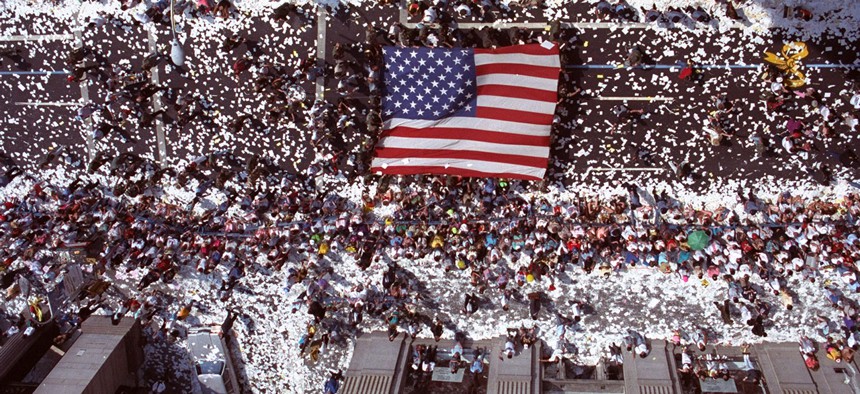
Marchers carry a giant American flag up Broadway in New York Monday, June 10, 1991, during Operation Welcome Home, the ticker-tape parade for returning veterans of Operation Desert Storm. Ron Frehm/AP file photo
Analysis: The Truth About Military Parades
Military parades say more about those who order and watch them than those who participate in them.
It is a safe bet that by the time the Pentagon does actually get around to giving Donald Trump the parade he has demanded, two things will have happened: First, the scale will be considerably less than the hundreds of M-1 tanks roaring up Pennsylvania Avenue deplored by many of the President’s critics; second, the current fuss will be long forgotten in the avalanche of scandals, crises, and constitutional battles that lie ahead.
Yet it is still worth considering what exactly these military parades mean, and why people get so exercised about them. And it is possible to do so without talking over much about draft-dodging presidents and why the troops hate rehearsals.
Victory parades are easy enough to figure out. The Grand Review of the Armies in May 1865 included 145,000 troops from three Union armies—of the Potomac, Tennessee, and Georgia—marching past cheering throngs of onlookers. There were some uncomfortable moments. General William Tecumseh Sherman, still bristling over what he regarded as unwarranted and brusque orders from Secretary of War Stanton, refused to shake the latter’s hand. But overall, the mood was joyous, albeit still shadowed by the assassination of President Lincoln little more than a month before. The armies marched down Washington streets for two days, and then quietly, almost instantly, melted away to their homes. The song “Goodbye Old Glory” was written in September 1865, but it caught the mood:
Four weary years of toil and blood,
With loyal hearts and true,
By field and fortress plain and flood,
We’ve fought the rebel crew,
But Victory is ours at last,
The mighty work is through,
Sound drums and bugles loud and fast,
This is our last tattoo.
“The mighty work is through.” That too was the mood of the victory parades for World War I held in New York and Washington in September 1919, some nine months after the armistice. 25,000 troops led by General John Pershing were cheered mightily, as they too received a nation’s thanks before returning to factory, farm and store. In January 1946 a similar parade through New York celebrated the end of World War II. It featured the 82nd Airborne Division, less, perhaps, because of the glamor of parachuting than because of its nickname: “All-American.” And, of course, there have always been local parades for units returning home from the wars.
The last real victory parade in the United States was after the first Gulf War in 1991. It involved 9,000 troops and plenty of kit, which spectators were free to gawk at and climb over at the Mall. This was a different kind of celebration: for a professional force, not for draftees and for-the-duration volunteers about to return to civilian life. It made more of a victory over a third-rate opponent than was seemly. In keeping with the over-the-top mood of the time, in fact, military leaders had given serious consideration to having the Iraqis sign the armistice on the quarterdeck of the battleship Missouri, where MacArthur had imposed peace terms on the defeated Japanese in Tokyo Bay in 1945. That ludicrous proposal, like the parade, reflected less the experience of the war than a deeper, if still uneasy, sense of having wiped away a disgrace. Like so much else from the First Gulf War, it was an attempt to banish the ghosts of the unsatisfactory outcome of Korea and the failure of Vietnam. A parade served, in this case, as exorcism.
Victory parades make one kind of sense. But there are other kinds of parades, such as those at the inaugurations of Presidents Truman, Eisenhower, and Kennedy. These included tanks and, in the cases of Eisenhower and Kennedy, atomic artillery and missiles. The United States stopped doing that. So too has another country which once celebrated its independence with a big military parade including hardware: Israel. The Israeli military parades ended in the 1970s. France, of course, has its elaborate and always spectacularly staged Bastille Day parade, which is the inspiration for our current debate. Its origins go back to 1880. France had suffered a humiliating defeat in 1870 at the ends of Germany; its politics were deeply factional, riven between secularists and Catholics, democrats and royalists. A military parade was a way of binding the country together. It became as well a symbol of French glory and power despite the unexpected defeat of 1870, the carnage of World War I, the catastrophe of 1940, and the humiliations of Indochina and Algeria.
Military parades with lots of hardware appeal to countries that have something to prove. For Israel in the 1950’s and 1960’s, it was that the tiny state had the muscle to survive; for France in the late 19th and 20th centuries that defeat and ruinous victory had not dimmed her martial prowess; for the first three presidents of the Cold War that the United States was the same country that had won World War II and could triumph in an entirely novel global contest against an opponent with weapons that could obliterate cities at a stroke.
Parades are also a way of paying tribute to the troops. The troops of the past, however, were citizen soldiers in the old sense: temporarily uniformed men (and later, women) who had answered their country’s call. As war has become for the vast majority of Americans a spectator sport, the problem becomes why, how, and to what extent public thanks is due. At one extreme there is the sentiment—darkly put out by John Kelly on a number of occasions, and most recently in his October 17, 2017, news conference about fallen soldiers—that civilians can not only never be grateful enough, but rather, must accept a position of permanent moral inferiority to those who serve.
That kind of parade becomes an act of moral extortion, a false claim to a monopoly of courage and civic virtue. It overlooks many things, including the fact that soldiers today are exceedingly well paid and cared for, and that most never experience hardships different than (indeed, often as bad) as, say, fire fighters. There are those, however, who think this is appropriate.
There is, finally, parade as exultation in raw power. At its ugliest, in the military parades of totalitarian regimes, it is a vaunting not only of might but of brutality. George Orwell had it right in England Your England:
A military parade is really a kind of ritual dance, something like a ballet, expressing a certain philosophy of life. The goose step, for instance, is one of the most horrible sights in the world, far more terrifying than a dive-bomber. It is simply an affirmation of naked power; contained in it, quite consciously and intentionally, is the vision of a boot crashing down on a face. Its ugliness is part of its essence, for what it is saying is, ‘Yes, I am ugly, and you daren’t laugh at me,’ like the bully who makes faces at his victim.
Americans don’t goose step. But they are not immune to an adolescent fascination with weaponry, and a celebration of raw strength. Hence the unseemly pronouncements in the current case by pundits and politicians, most of them remarkably devoid of military experience themselves or among their children. One thing they may miss is that a military parade would show off some really old pieces of hardware, first designed and deployed (if modernized since) over 30 years ago—M-1 Abrams tanks, Bradley Fighting Vehicles, F-15 jets. One thinks of the aging alpha male baboon who attempts to intimidate the rest of the troop by baring his teeth, but has failed to notice that some of his fangs have dropped out. The Chinese colonels taking careful notes might be less impressed than the talking heads of Fox News.
What parades do not do is adequately celebrate today’s soldier and his or her spirit. What they do not show is the personal appreciation Americans should appropriately offer men and women who have repeatedly left family behind for danger and boredom, often leaving pieces of who they once were on the battlefield. What they do not do is replace the barbecue or the beer, the patience with the far-away look and sudden irritability, the long walk and the arm around the shoulder, the welcoming smile and the attentive ear.
Thirty-five years ago, during my own brief and inglorious Army reserve career, I went to an officer’s basic course with D. J. Reyes, who unlike me, later spent nearly 34 years doing hard work in hard places, including serving as then Major General David Petraeus’s intelligence officer for the 101st Airborne Division in Iraq. “Quiet warrior, quiet professional is the motto,” he recently reminded me. We should respect that spirit, realizing that Orwell was right, and that parades say more about those who order and watch them, than those who participate in them.







